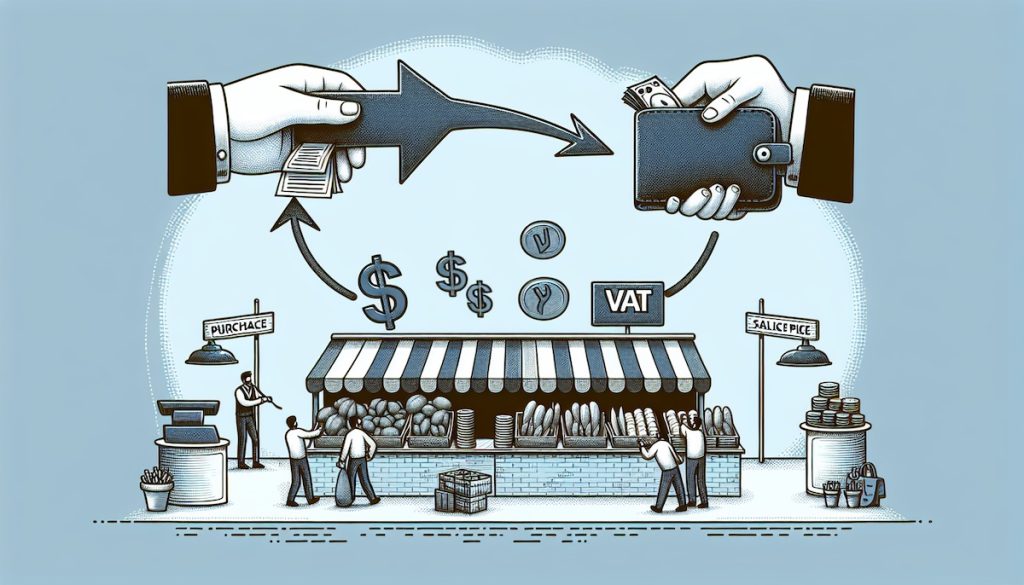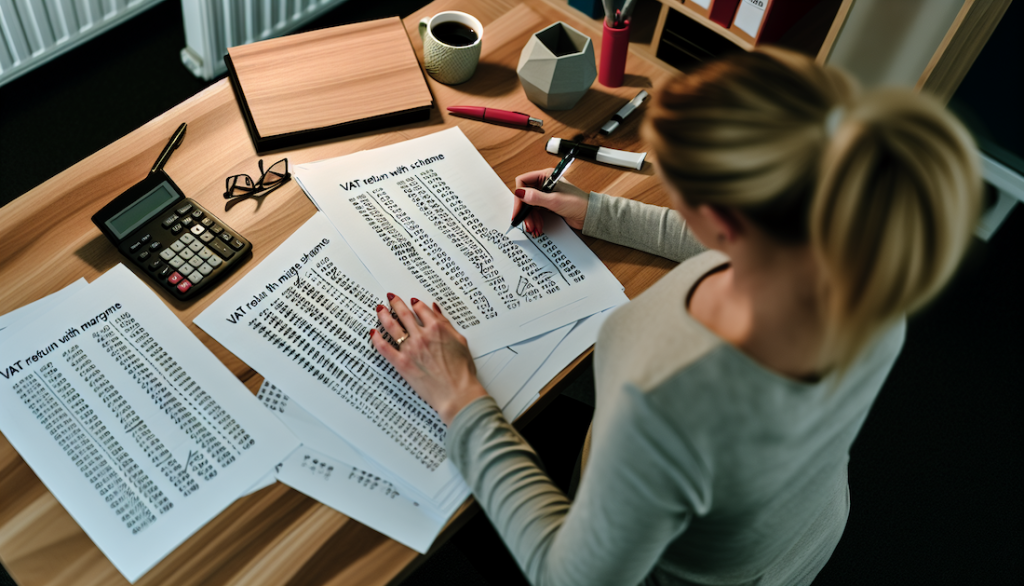Maximising profits with the VAT margin scheme: A guide for businesses
Navigating tax efficiencies can be transformative for businesses dealing in second-hand goods, art, or antiques. The VAT margin scheme offers a way to levy tax only on the profit margin, not the total sale amount. Dive into our guide to discover if you’re eligible, how to implement the scheme, and the ways it can benefit your bottom line.
Overview:

Understanding the VAT margin scheme
The Simplified VAT margin scheme is an optional method of accounting for VAT that allows businesses to calculate VAT only on the profit margin of eligible goods. In essence, it taxes the difference between the purchase price and the selling price, known as the margin, rather than the full selling price.
Consequently, the scheme excludes the VAT on:
- business overheads
- repairs
- parts
- accessories
When calculating the margin, it’s essential to use a margin scheme to ensure accuracy and efficiency.
For instance, imagine buying a second-hand bag for £50 and selling it for £70. The VAT, under the margin scheme, is calculated from the £20 difference, not the entire £70. This unique approach to taxation allows businesses to pay VAT more efficiently, reducing the amount of VAT owed and enhancing the competitive edge. By understanding how to reclaim VAT under the margin scheme, businesses can further optimise their tax payments.
The basic concept of VAT margin schemes
To better understand the concept of VAT Margin Schemes, consider an example. If a VAT-registered business purchases an antique bookcase for £1,000 and later sells it for £1,400, it will need to account for VAT on the sale price. The VAT, under this scheme, is charged only on the £400 margin, which would be £66.68 at current VAT rates, not on the full £1,400 selling price.
This concept is at the heart of the VAT margin scheme, offering businesses a unique and beneficial approach to accounting for VAT.
Benefits for VAT-registered businesses
The benefits of the VAT margin scheme are manifold. Primarily, it allows businesses to pay VAT only on the profit margin, leading to a lower tax burden. This approach, as opposed to charging VAT on the entire selling price, results in a typical VAT rate applied to the margin of 16.67%.
Furthermore, businesses using the VAT margin scheme can:
- Sell items at a price lower than their purchase cost without the obligation to account for VAT on such sales
- Enhance profit margins and reduce the total cost of sold goods
- Optimise financial operations by leveraging VAT calculated from added value instead of total revenue.
Get in touch with one of Sleek’s many experts today!

Qualifying for the VAT margin scheme
To tap into the benefits of the VAT margin scheme, businesses first need to qualify. A critical prerequisite for scheme eligibility is being VAT registered. Non-VAT registered businesses, or those with a turnover below the VAT threshold, can become eligible for the scheme by voluntarily registering for VAT. However, the VAT margin scheme is optional for second-hand goods, and businesses can choose whether to apply it to eligible sales.
It’s worth noting that the scheme can be applied selectively to eligible second-hand sales but cannot be used for intra-community sales subject to standard VAT rules.
Businesses must meet all the scheme’s requirements to avoid being charged VAT on the full selling price, which could significantly impact pricing strategies and profitability. To use one of the margin schemes, businesses must apply to HMRC and select the one that best fits their operations.
Eligibility criteria for businesses
Businesses must fulfil specific eligibility criteria to participate in the VAT margin scheme. This ensures that only qualified businesses can take part in the scheme. The eligibility criteria include:
- Being VAT registered (mandatory or voluntary)
- Meeting the requirements set by the tax authorities
- Dealing in eligible goods or services
- Complying with the rules and regulations of the scheme
Being VAT registered is a vital requirement, whether it’s mandatory or voluntary. This registration enables businesses to leverage the tax benefits of the scheme, aiding in overall profitability. It’s essential to note that while businesses must be registered for VAT, the scheme itself does not require separate registration.
Determining eligible goods
The range of goods eligible under the VAT margin scheme is broad, encompassing second-hand goods, works of art, antiques, and collectors’ items, as well as specific vehicles and agricultural machinery acquired after January 1, 2010. However, certain items are excluded, such as those purchased with VAT charged, precious metals, investment gold, precious stones, and new or imported vehicles.
Businesses must recognise that to benefit from the VAT margin scheme, the goods sold should be second-hand, collectable, or qualify as art or antiques, with careful consideration of exceptions and specific criteria
Implementing the margin scheme in your business
Once your business qualifies for the VAT margin scheme, the next step is implementation. An essential element of this process is proper record-keeping. Electronic invoicing in VAT margin schemes enables better traceability, reduces paperwork, and allows for faster access to data. For VAT purposes, businesses usually have to keep records like accounts, bank statements, and invoices for at least 6 years, but HMRC may permit less stringent storage requirements under certain circumstances.
In addition to record keeping, staff members must be trained on the margin scheme specifics, including the calculation of margins and issuing correct invoices. This training is crucial for compliance and accurate VAT returns. Properly recording and linking business transactions through a VAT account is key to correctly filling out the VAT Return when implementing the margin scheme.
Record-keeping and invoices
Detailed and accurate record-keeping is vital under a margin scheme. This includes tracking the purchase price and the selling price of each item. Maintaining up-to-date records that are distinguishable from other records is a requirement to ensure accuracy and compliance. While there is no special application process for using a VAT margin scheme, records such as a stockbook must be kept.
Invoices issued under a margin scheme should indicate that the scheme has been applied without showing VAT separately. Each VAT invoice issued must be retained, forming an essential part of the business records. This meticulous approach to record keeping is paramount for accurate reporting on VAT returns under the margin scheme, ensuring businesses fully leverage the tax benefits of the scheme.
Global accounting calculation method
For businesses dealing in high volumes of low-priced qualifying items, the Global Accounting Scheme offers a simplified solution. As a variant of the VAT margin scheme, it streamlines the VAT process for bulk or mixed sales. However, businesses must adhere to rules specific to this scheme when pricing items, which can affect their strategic pricing models.
Under the Global Accounting Scheme, VAT is calculated based on the total margin between eligible purchases and sales during a VAT period, not on a per-item basis.
To compute the VAT owed under this scheme, the gross margin—derived from subtracting the total purchase price from the total selling price of eligible items—is multiplied by 1/6. If the total purchases exceed total sales within a period resulting in a negative margin, no VAT is due, though this negative margin is carried forward to the next period.

VAT margin scheme for international trade
The applicability of the VAT margin scheme extends beyond borders. Businesses within the UK, EU, and other countries recognizing domestic VAT laws are eligible to participate. However, different VAT rules must be considered when selling to customers in other countries using the VAT margin scheme. For instance, margin scheme sales cannot be reported in the OSS VAT return for cross-border sales within the EU.
Special rules also apply when importing items such as works of art, antiques, or collectors’ items from outside the EEA and when acquired from creators or heirs. Businesses may choose to use the VAT margin scheme for certain imported goods if they do not recover import VAT. In cross-border transactions, foreign currency prices must be converted into sterling at the current exchange rate to calculate the margin.
Get in touch with one of Sleek’s many experts today!

Completing your VAT Return with margin schemes
Completing a VAT Return with margin schemes involves accurately reporting the following:
- The VAT due on all eligible goods sold in the return period should be included in Box 1 of the VAT return.
- The full selling price of all eligible goods sold within the return period, minus any VAT due on the margin, should be reported in Box 6.
- The full purchase price of all eligible goods bought within the return period should be entered in Box 7.
Margin scheme purchases or sales are not required to be listed in Boxes 8 and 9 of the VAT Return. Adjustments to the VAT account, such as for credit notes or corrections to previous returns, must be recorded in functional-compatible software.
Businesses must keep proof of purchase and sale through invoices and receipts when filling out the VAT Return under the VAT margin scheme, ensuring the correct VAT payable is calculated.
This meticulous approach to VAT returns is crucial for accurate VAT reporting and ensuring businesses fully benefit from the tax advantages of the scheme.
Pricing strategies using the VAT margin scheme
The implementation of the VAT margin scheme necessitates adjustments in pricing strategies. Businesses must take into account the impact of the VAT margin scheme on VAT calculations when setting their selling prices.
The selling prices should be set by considering the margin between the purchase price and the selling price, taking into account that VAT is only payable on this margin. This ensures profitability after VAT is accounted for by planning for the VAT that will be paid at 16.67% on the margin.
Fair and reasonable methods to value stock on hand help in accurately calculating the margin and the VAT due. To maintain competitive pricing, it is critical to calculate the VAT due by determining the gross margin and applying the one-sixth rule. By maintaining correct records and including them in their VAT Return, businesses can start using a margin scheme at any time, thereby optimising their tax savings.
Get in touch with one of Sleek’s many experts today!
Special considerations for second-hand cars
Second-hand cars have specific rules and considerations under the VAT margin scheme. They are eligible if they have been used on the road for business or personal use and are suitable for further use. However, new vehicles, imported vehicles, those on an invoice with separate VAT, category A and B write-off vehicles, or those previously sold under standard VAT rules are not eligible.
When setting the sales price, all receipts from the vehicle sale must be included, such as incidental expenses directly related to the sale and payments for any accessories fitted before the sale. In cases where an agent is utilised for the vehicle sale, their service charges must be taken into account in the final selling price for the VAT margin calculation. Special rules apply specifically to second-hand cars in the VAT margin scheme, which must be followed for proper VAT reporting.
Summary
In conclusion, the VAT margin scheme offers a unique approach to taxation, enabling businesses to pay VAT on the margin rather than the full selling price. This method reduces the tax burden, enhances profit margins, and maintains market competitiveness.
Whether you’re a VAT-registered business dealing in second-hand goods, works of art, antiques, or collectors’ items, or a business considering voluntary VAT registration, the VAT margin scheme could be a game-changer for your profitability.
FAQs
No, buyers cannot claim back VAT on purchases made under the VAT margin scheme, as it is not possible to reclaim VAT on these transactions. If both you and the customer are VAT-registered, it’s up to you to decide whether to use the margin scheme or not.
The margin scheme VAT is calculated at 16.67% (one-sixth) of the selling price, based on the difference between the purchase and selling price.
The margin scheme applies to second-hand goods, works of art, antiques, and collectors’ items, allowing the seller to pay VAT on the difference between the purchase price and the selling price rather than on the full selling price. This benefits both the seller and the buyer.
The VAT margin scheme taxes the difference between the purchase and sale price of certain items at a rate of 16.67%. It is commonly used when selling second-hand goods.
Businesses can qualify for the VAT margin scheme by being VAT registered, which is an essential requirement for eligibility. Non-VAT registered businesses or those with turnover below the VAT threshold can also join the scheme by voluntarily registering for VAT.








